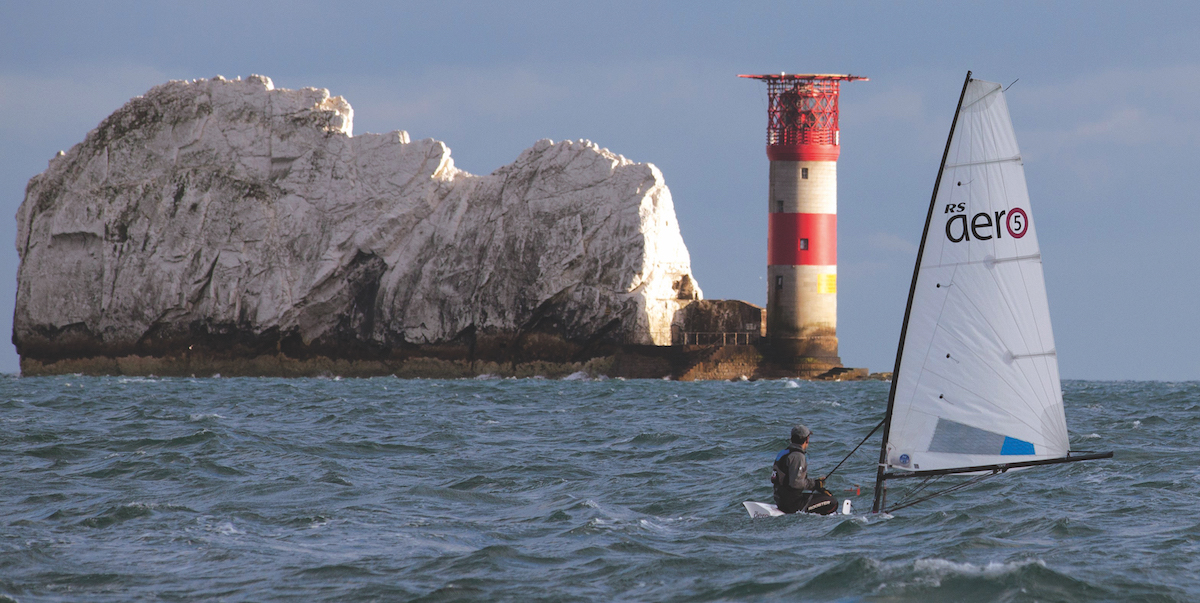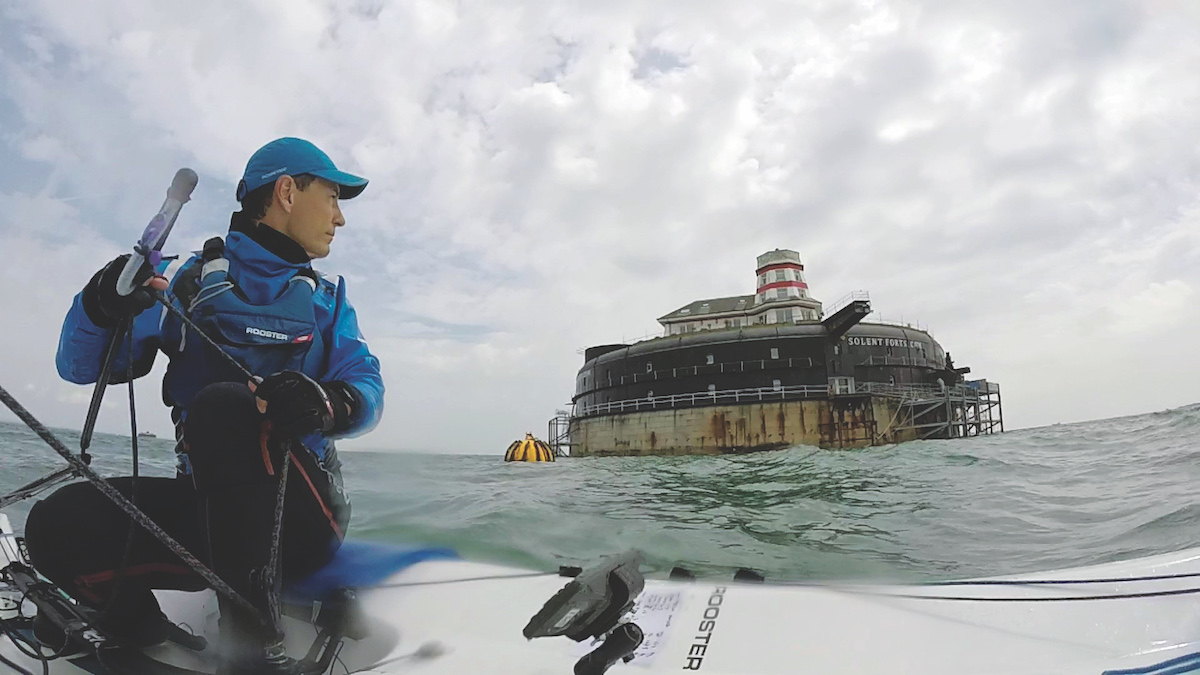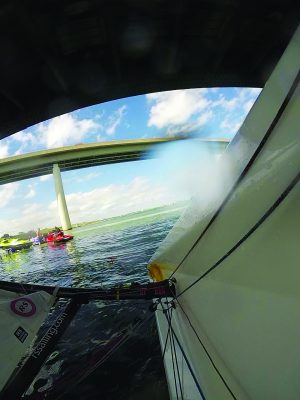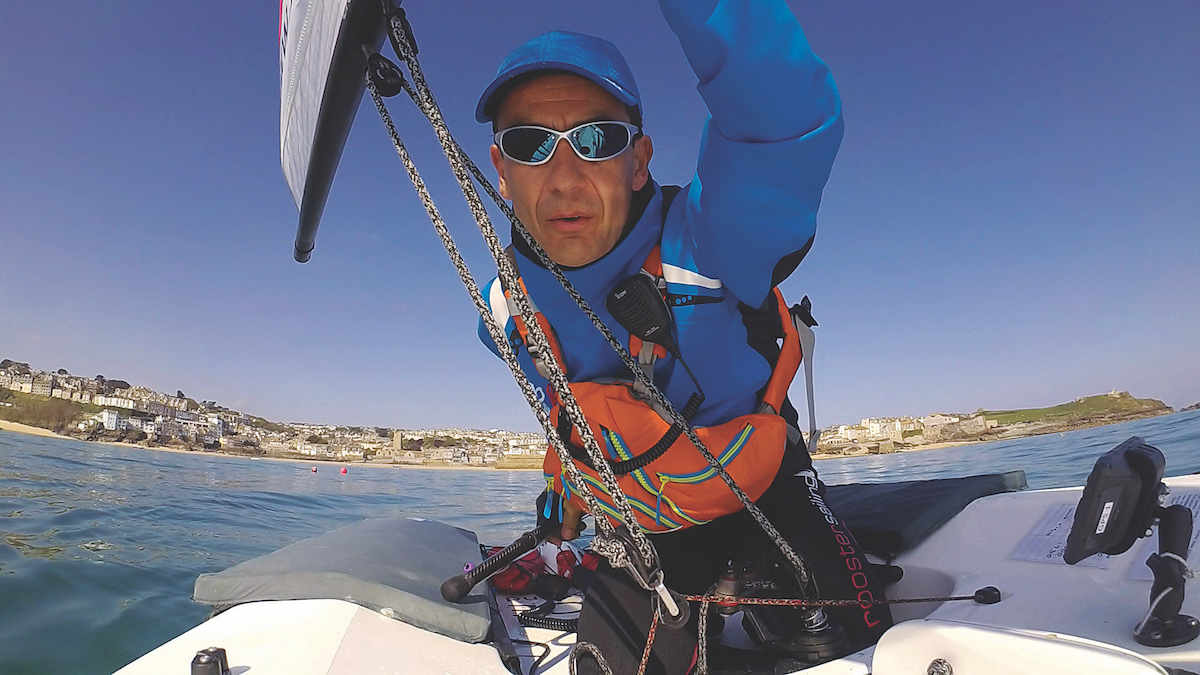Ken Fowler sets sail on a unique challenge to round all the islands of England and Wales, and learns some intriguing history along the way
Funny how small ideas in life often turn in to bigger ones. The Yodare challenge is definitely one of those. What started out as sailing around one solitary island in 2015 has now morphed into sailing round all the islands in England and Wales – that’s over 200 islands at the last count – although unfortunately I keep discovering more! So how did this sailing odyssey come about and what’s it like to take on the many varied challenges of the British coast in a 4m dinghy?

In 2015 I turned 50 and, more poignantly, it was the point at which I’d lived more of my life without my father, than with him. He died of cancer when I was only 24. He was from a family of six siblings, five of whom were taken by cancer. To commemorate his life and to mark this milestone I sailed a Laser dinghy around the Isle of Wight to raise funds for Cancer Research and Oakhaven Hospice in Lymington. That 72-mile adventure raised over £3,000 and most surprisingly, also earned me a nomination for a national sailing award. Although I didn’t win, coming runner-up was a fantastic achievement and seemed to be the catalyst to people suddenly approaching me with “What’s your next adventure – sailing round Britain?”
That idea sparked my interest and after some extensive research, including reading Land On My Right by Ron Pattendon, I knew this was the adventure for me, but with the complications of a full time job and a family it just wasn’t feasible. So instead of sailing all the way round Britain I narrowed my goal to sailing from Lands End to John O Groats in a small dinghy! That 865-mile challenge had to be completed in 31 days as that’s all the leave I could get from my job, so the title for the adventure was born – Race to Scotland.

Yodare at John O Groats
Setting off
After 18 months of preparation I finally set sail from Lands End on 07 May 2017 in Yoda, my 4m, 30kg RS Aero dinghy. It was an adventure of highs and lows where the weather constantly challenged my progress northwards. The first few days typified the difficulties that were to shape the challenge, an unseasonal north-easterly wind created a 138-mile beat up the north Cornish and Devon coasts. As the journey continued the complications didn’t abate with fog banks, nuclear submarine exercises, giant whirlpools, hours of paddling and the odd RNLI rescue! In the end the challenge finished just 40 miles short of John O Groats as weather and time defeated me. I’d given it my all, but had to accept defeat. The real purpose of the adventure had been to try and raise £50,000 for the two charities. It was a colossal target but thanks to the generosity of many people we raised an amazing £37,000 which was staggering, but still short of the target.
In order to raise the remaining £13,000 I needed another challenge and so Yodare (based on my boat’s name Yoda and ‘You Dare’) was born. Yodare came from the inspiration of my first adventure and the fact that on Race To Scotland I’d sailed past so many islands that I never had the chance to explore the other side of. I decided to rectify this by setting myself the challenge to circumnavigate as many islands that were reachable from my South Coast home. Although the islands of the West Coast of Scotland had blown me away with their beauty, their distance from home and the sheer number of them – roughly about 900 – meant they were just unachievable. However, all the islands in England and Wales sounded like a challenging target, and offered some hope of being completed. After extensive research, I discovered there was no clear definition of what an island was, so the first thing I needed to do was to make this definition!

Photo: Yodare’s final destination – the Needles and the Isle of Wight
I settled upon the criteria that an ‘island’ should be permanently visible at high tide and at least 30m in length – otherwise I’d be chasing every rock in the sea! Having set the criteria I discovered that there were around 183 islands, far more than I suspected and quite daunting, especially coupled with the estimated 1,000 miles of sailing needed to successfully round them all. But the goal was set – to become the first person to sail all the islands in England and Wales in a dinghy. Funnily enough no one else had been foolhardy enough to attempt it.
Sailing round islands sounds simple, but brings with it many different challenges, including finding launching sites, tides that stop islands being islands, bridges, roads and all the normal challenges of sailing close to hostile coastlines. Finding launch and landing sites has been one of the biggest obstacles. There is often no nearby harbour or slipway to an island and this means either sailing a really long way to get around what could be a very small island, or finding an alternative type of launch site nearer to the island. Google Earth has really helped me identify beaches and coves with road access, many of which have probably never seen a boat launched from them. The north Cornish coast is one of the more challenging areas of the Yodare challenge as it has a distinct lack of safe harbours. Surf beach launches are sometimes the only option, but the challenge is to find those sheltered enough from the prevailing conditions to enable safe launch and recovery. These locations can vary from day to day based on the vagaries of the local weather system and all of them seem to involve a long drag across the beach with the trolley wheel sinking in the sand, at the beginning and end of the day’s sailing! I was so glad Yoda only weighs around 30kg!

After landing in the surf, Ken and support team member Earl wade back up the Hayle river
Being out on the open seas in a 4m dinghy is not to be taken lightly and safety is always at the forefront of my mind. There are numerous days when despite having travelled hundreds of miles, I’ve had to say ‘no’ to sailing because of the conditions. It’s frustrating because I know it means another long journey to re-attempt the island on another day, but managing safety is key when undertaking challenges such as this. On those days when it is safe to sail, I’m a regular user of the RYA SafeTrx app to ensure that everyone is aware of my location and plans. A live tracker kindly supplied by YB Tracking also helps supporters and my ground support team to follow my progress live on the internet. It’s also invaluable if the RNLI were ever to be called out. On board Yoda I have a Garmin GPS for navigation, a PLB attached to my buoyancy aid and a VHF radio and electronic flare. Sometimes it might feel like a bit of overkill on short island hops, but I discovered from Race To Scotland that you never know what each day will bring, so go out there fully equipped just in case.
As well as offering a sailing challenge, the islands bring with them intriguing histories ranging from Deadman’s Island in the Medway estuary – where coffins are literally floating to the surface – to Hilbre Island where lifeboatmen would have had to either ride on horseback, or row to just get to the lifeboat station before launching their rescue. Finding out about the islands before every rounding brings them to life for me as I scan for abandoned fortifications from the past or hidden smuggling beaches.
Intriguing island stories
Great Mewstone in Devon typifies these stories. In the 1700s petty criminal Sam Wakeham escaped transportation to Australia by being marooned on Great Mewstone for seven years instead, because it was cheaper for the local council! No island ever feels the same and each one seems to engage me in a different way, whether it’s the stunning terrain, the tidal challenges or its place in history.
Some days can be long and challenging. Launching from Plymouth Sound with reports of 25 knots on the breakwater, I sailed round Drake’s Island and then left the sanctuary of the harbour in search of Great Mewstone and Burgh Island. Beating into big waves and an ever strengthening wind, I was soon dwarfed by the towering pinnacle of Great Mewstone, the solitary house of its once prisoner inhabitant looking down upon me fighting my way through walls of spray spinning off the wavetops. After just over five hours of beating I finally rounded the last island of that day, Burgh Island, and its art deco hotel where Agatha Christie wrote some of her most famous novels.
The sea around the island creates double crossing waves as the tide rounds from both directions, which means you are suddenly surfing a wave with another wave coming directly at you from the opposite direction – very disconcerting.
Landing just as the last of the beach disappeared brought the end to a 26-mile adventure that had bagged three islands and left me totally drained, typifying the arduous nature of this island challenge.

Rounding the man-made islands that house the Solent Forts
The Oxford Dictionary definition of an island also included man-made structures and as man has blocked off lots of islands such as Canvey Island, it felt appropriate to include the Solent Forts in this adventure. Sailing all four forts in a day made for a different sailing focus, with huge container ships transiting the main channel between the forts completely dwarfing my Aero. The haunting abandoned fortifications of Horse Sand Fort provided a complete contrast to the luxury hotel that is Spitsand Fort.
Not all days run to plan and just getting out to sea and back again can be a challenge in itself. Godrevy Island in St Ives Bay typifies this. As the bustling narrow streets of St Ives were not conducive to campervans towing dinghy trailers, my launch site for Godrevy had to be from the Hayle river.
Advantage of tides
Wanting to take advantage of tides along the coast meant leaving the Hayle river on a dropping tide, which unfortunately meant that about 400m short of the sea, the river became too shallow to sail.
A long wade and drag finally got me to the surf break line and at last the sailing proper could begin. Having successfully rounded Godrevy Island and its stunning lighthouse I decided that conditions had deteriorated too much to risk sailing down to The Carracks, especially as there were no emergency landing site options. This was a sensible move, but meant having to land through the surf and then drag Yoda over the beach and up a kilometre of the shallows of the Hayle river. Not quite a pontoon marina arrival!

The rivulet around Mersea Island that Ken needed to sail
Mersea Island in Essex was a very challenging island to round especially as it’s connected to the mainland by a causeway with a two-lane tarmac road – not sailing friendly! The island is home to an annual around the island sailing race where competitors’ boats are carried across the road at high spring tides by an army of local volunteers. We didn’t have an army of volunteers or the biggest of spring tides, but if we arrived at the causeway at high tide we’d only have a short carry across the road. As I looked at the channel at low tide all I could see was a rivulet of water surrounded by what seemed like acres of mud. I just couldn’t imagine it being sailable, but if we got our arrival time in theory it should be a wide channel. Heading off in a Force 4-5 into the Blackwater Estuary I was soon passing the sole windsurfer and enjoying some unexpected surfing conditions. As I turned north and westwards into the Pyefleet Channel the water flattened and the reed lined channel began to narrow. As I approached the causeway it was a constant series of tacks to stay within the narrow channel. So narrow that anything longer than five seconds on a single tack meant grounding on the daggerboard-sucking mud. At last the causeway was reached where Ian and Jane, my support crew that day, helped lift Yoda past the puzzled motorists speeding along the B1025. Another 38 tacks the other side of the causeway and at last Yoda returned to the launch point at West Mersea, another island bagged and 13 more miles added to the sailing total.
A weekend of sailing in Kent provided the varied challenges of marsh-covered islands in the Medway estuary and the novelty of participating in a genuine race around an island, the Isle Of Sheppey race. The islands of the Medway were a complete maze and never had I been so glad of the Garmin GPS to help me navigate a path round all the islands.
Having launched from what felt like the longest slipway in the world at Queenborough the eerie abandoned forts of Fort Hoo and Fort Darnet provided the only signs of habitation on these bleak low lying islands and I was glad to safely round the ominously named Deadman’s Island without any mishaps! Having rounded nine islands and covered just over 30 miles of sailing there was no rest as the next day was the 27-mile round the Isle Of Sheppey race. It felt novel sailing the island with others and the distraction of other dinghies all around helped pass the near-five hours that it took to sail round the island.

The highlight had to be having to capsize Yoda to pass under the Sheppey Way road bridge that crosses the River Swale! I can’t ever remember a race with such an obstacle!
While the focus of this challenge has been on coastal islands, I have also included islands of The Lake District. It offered the opportunity to sail around the inspiration for Swallows and Amazons and provided some challenging sailing. From the gusty winds of Thirlmere to the 14-island maze that is Windermere, each one focussed my sailing skills and I was often glad of Yoda’s shallow draught as daggerboard and rudder were lifted to squeeze through the shallowest of gaps. Yoda may have already become the first sailing dinghy to sail around every island in the Lake District (all 26 of them) but the bigger challenge of becoming the first dinghy to sail around every island in England in Wales still remains.
My original plans for 2020 involved over 100 islands, including a trip to the Isles of Scilly. Unfortunately, the shadow of coronavirus has thrown all those plans up in the air and a recent trip to South Wales, Devon and Cornwall to round another 16 islands has been the only safe sailing that could have been achieved this year so far.
On this trip we were up before sunrise to catch the tide and sail around the islands of Torbay, only to have to wait for over four hours for the wind to arrive! I’m learning that this challenge will require a lot of time and patience, but with 94 islands already sailed I’m not planning to give up any time soon. While the future still remains uncertain, I continue to make plans and research the navigational challenges that each island provides, hopefully awaiting the opportunity to put those plans into action.
More and more islands
Many challenging islands still remain, especially those around the West Pembrokeshire coast, the long rounding of Anglesey and the furthest offshore island, Lundy. No island is ever easy and their varying challenges have improved my sailing skills and I’m sure will continue to do so. This island odyssey has also taken me to numerous locations that I’ve never visited (let alone sailed) and I continue to be blown away by the stunning scenery of the Welsh and English coastlines. The only drawback is that I seem to be discovering more islands and the original 183 target has now grown to in excess of 200 islands!

Leaving St Ives
Looking to the future, the hope is to culminate this adventure where it all started by making the last island the Isle of Wight. Although Yoda will always be far too small to be allowed in the official Round The Island Race, the opportunity to launch and recover from my home club, Highcliffe Sailing Club, will hopefully be a fitting way to bring this challenge to a successful conclusion. There are still many islands to circumnavigate before that day, many more adventures to be had, but it feels good to have a final goal to be focussed on. Most importantly the funds raised by Yodare continues to rise and we are now over half way towards our target; that will be the ultimate judgement on the success of this sailing adventure. It feels good to be sailing with a real purpose and using sailing to support such wonderful, life changing causes.
And finally if you think you know any islands I might have missed then just drop me a line – Yoda is always up for the challenge!
- Follow the adventures of Yoda at yodare.co.uk, where there are blogs on the islands, a schedule of what’s coming up next and a live tracker to follow Yoda live on the water
- For more amazing adventures click here or take a look PBO’s YouTube videos.



